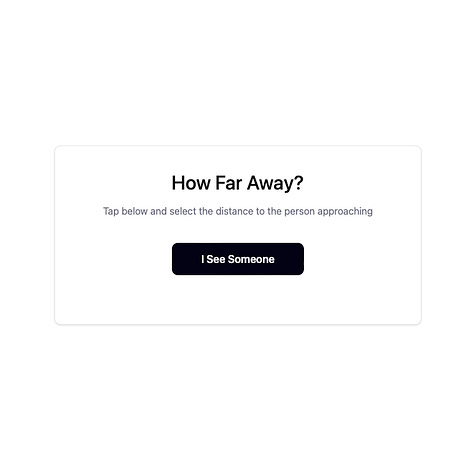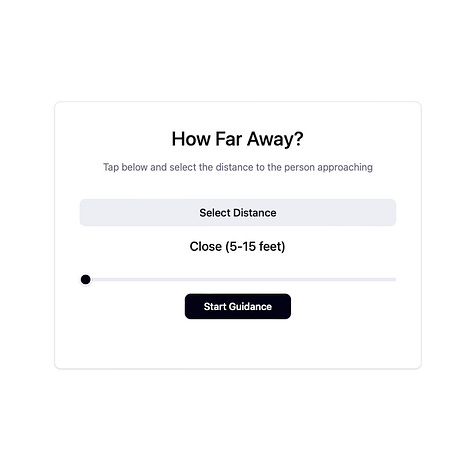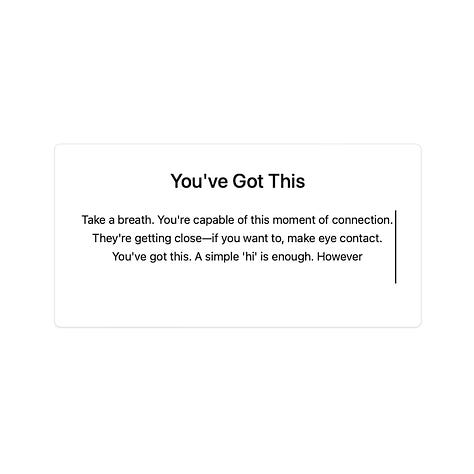How to Say "Hello"
Building Tools for Connection Across Divides
I’ve been walking the same streets in Echo Park for three years now, and I still can’t figure out the greeting choreography. Maybe it’s the Mountain town sensibilities I was raised with but I try to at least acknowledge the people I pass on the quiet morning streets. Alo-clad parents rushing their kids into school, abuelas tending to their gardens, couples walking their dog back from Canyon. What should be a simple gesture ends up being, like most, way more complicated than you’d think. After months of practicing, I have devised my own personal approach:
⊹ Avoid eye contact until about 30 feet away – what’s that across the street? up in the sky? (look literally anywhere else)
⊹ Take a quick glance (best if out of the periphery to see if they’re already looking at you)
⊹ Look away and then let your eyes fall onto them regularly until you might lock eyes (you only have a few more feet to go)
⊹ If they’ve engaged your eye contact, seem to be preparing themselves for an impending interaction
⊹ If all of the above, when you are within voice distance, you may employ any of the following tactics:
Say hello
Purse your lips into a small smile
Nod your head
I, of course, prefer a more systematic approach but I have a feeling that all of us have devised their own protocols for how to engage with another human in the world. I have been wondering what makes us decide, in that split second, whether to acknowledge the human walking toward us or pretend they don’t exist?
This question became the seed for my current project through the Social Software Cycle with Lauren McCarthy at UCLA. I’m building a prototype app — let’s call it a “greeting coach” — that gives you real-time audio prompts as you walk past neighbors: small nudges of confidence, cultural context, or just permission to try. As I tinker, I’ve been trying to release my instinct to spend months building something polished and perfect before showing it to anyone. Instead, I’m forcing myself to work quickly and messily, testing rough ideas with real people in real neighborhoods.



Before testing anything, though, I need to understand what I am actually encountering. I’ve been researching interpersonal greetings, and what I found was humbling: this seemingly simple act is profoundly complex, especially in gentrifying neighborhoods like Echo Park where multiple cultural frameworks collide. In Latino culture, not greeting someone you pass can be deeply disrespectful — a denial of their humanity. In Northern European and Anglo-American urban norms, greeting strangers is often seen as intrusive, with civil inattention functioning as a form of respect. Meanwhile, the research on women’s navigation of public space, racial profiling, and the dangers marginalized communities face from unwanted stranger interactions revealed that encouraging people to say hi can increase the burden on those already doing the most defensive work just to move through the world safely. The challenge is about designing across fundamentally different — and sometimes contradictory — needs for safety, autonomy, belonging, and cultural respect.
I’m using these complex factors as guides through the next phase of public prototyping, asking myself: Can a tool help people navigate the micro-moment of “do I say hi or not?” with more confidence and cultural awareness? Can it create space for the kind of brief, low-stakes acknowledgment that might make someone feel a little less alone in their own neighborhood? I’m designing multiple versions to test — real-time prompts, cultural education, opt-in signaling systems — and planning to take them into Echo Park streets for community feedback. The goal is to learn what works for whom, what feels helpful versus intrusive, and whether this intervention should even exist. Eventually, I’d love to share a version with you all to test in your own neighborhoods—to see how these dynamics play out differently depending on where you are and who you’re encountering.
But first, a question for you: What makes you decide whether to say hi to someone on the street? When do you greet strangers and when do you look away? What variables matter — time of day, how you’re feeling, who’s walking toward you, whether you’re in your own neighborhood or somewhere else? Have you had a greeting interaction that felt particularly good or particularly wrong? I’m building a map of these micro-decisions, and your reflections will help me understand what I’m actually designing for.
Drop your thoughts in the comments. The most interesting design insights often come from noticing the patterns in our own contradictions.
Seeds
⊹ In a 1992 interview from Havana, Assata Shakur warns against revolutionary rhetoric that can’t connect to people’s actual conditions—the arrogance of organizers who assume everyone’s reality is the same. Her call to “become much more sensitive to the objective conditions that people are dealing with” cuts right to my tension about working across communities: how do we build together without flattening difference or imposing frameworks that don’t serve people’s lived struggles?
⊹ Welcome to the “Post-Naive Internet”. Researchers at co–matter wrote with the Mozilla Foundation about community-owned platforms and cooperatives emerging after web3’s collapse. The shift is from building universal alternatives to creating “miniverses” for specific communities. Reading it, I am wondering if we’re all on separate islands, what enables collaboration across them? And how do lessons transfer between digital infrastructure and physical organizing — fighting displacement, resisting surveillance, and controlling our actual neighborhoods?
⊹ Experience a preview of Kahlil Joseph’s forthcoming feature, BLKNWS: Terms & Conditions. It refuses to be a documentary — instead it’s a “fugitive newscast” that mixes archival footage, speculative narrative, and collective fabulation by Black scholars into something that feels like an album’s rhythm. I saw him speak in LA last year and his work has been my north star for SURROUND SOUND: how do you use archives not as evidence but as material for fiction, creating alternate pathways through history that surface what the official record tried to contain?







Id say I say hi if they look friendly and i feel like it. Sometimes i wait for them but other times i just wont say hi to anyone. Mood.
I appreciate your ability to take a seemingly simple concept apart. I think the digital age has mostly atrophied our social acumen, but it can also be used in bite-sized ways to restore some of that.